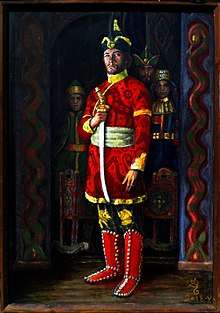Levedi
Levedi, or Levedias, Lebedias, and Lebedi was the first known voivode of the Hungarians.[1] Levedi's wife was a Khazar princess, and he was close to the Khazar ruling dynasty. He may himself have been part Khazar. According to Constantine VII Porphyrogenitus' De administrando imperio, the Khazars sought to make Levedi the paramount ruler of all the Hungarian tribes, but he refused, possibly because he was childless or because his close ties to the Khazar government were resented by other Magyar leaders. Instead, Levedi proposed Álmos and his son Árpád as leaders of the Magyars. The Magyar settlement between the Volga river and the Urals the mountains were named Lebedia soon to become Levedia after Levedi.[2]
| Levedi | |
|---|---|
| voivode of the Hungarians | |
 Modern portrait by Tulipán Tamás | |
| Reign | early 9th century (?) |
| Successor | Álmos (?) |
Name and title
The only source of Levedi's life is the De administrando imperio,[3] a book written by the Byzantine Emperor Constantine Porphyrogenitus around 950.[4] According to historian Omeljan Pritsak, Levedi's name, which was actually a title, derived from the Turkic expression "alp edi", or "brave lord".[3] The Hungarian historian Gyula Kristó, who refuses Pritsak's theory, says that Levedi's name is connected to the Hungarian verb "lesz" ("be").[3] A similar proper name (Lewedi) was recorded in a Hungarian charter, issued in 1138.[3]
When writing about Levedi, Porphyrogenitus emphasized "the illustriousness of his race".[5][6] Porphyrogenitus's narration suggests that Levedi was born between around 800 and 815, because he seems to have been older than Álmos who was born in the 820s.[7] Levedi bore the title "voivode", which is of Slavic origin.[8] When using that title, Porphyrogenitus always referred to the heads of the seven Magyar tribes.[7] Historian Dezső Paizs says that Levedi was the head of the Megyer tribe, but his theory has not been widely accepted.[6]
References
- Gyula Moravcsik, Constantine Porphyrogenitus de Administrando Imperio, Dumbarton Oaks Center for Byzantine Studies, 1967, p 171
- http://www.grozerarchery.com/magyar.htm
- Kristó 1996, p. 112.
- Engel 2001, p. 8.
- Constantine Porphyrogenitus: De Administrando Imperio (ch. 38), p. 171.
- Kristó 1996, p. 9.
- Kristó 1996, p. 114.
- Kristó 1996, p. 115.
Sources
Primary sources
- Constantine Porphyrogenitus: De Administrando Imperio (Greek text edited by Gyula Moravcsik, English translation by Romillyi J. H. Jenkins) (1967). Dumbarton Oaks Center for Byzantine Studies. ISBN 0-88402-021-5.
Secondary sources
- Berend, Nora; Urbańczyk, Przemysław; Wiszewski, Przemysław (2013). Central Europe in the High Middle Ages: Bohemia, Hungary and Poland, c. 900-c. 1300. Cambridge University Press. ISBN 978-0-521-78156-5.CS1 maint: ref=harv (link)
- Cartledge, Bryan (2011). The Will to Survive: A History of Hungary. C. Hurst & Co. ISBN 978-1-84904-112-6.CS1 maint: ref=harv (link)
- Engel, Pál (2001). The Realm of St Stephen: A History of Medieval Hungary, 895–1526. I.B. Tauris Publishers. ISBN 1-86064-061-3.CS1 maint: ref=harv (link)
- Kristó, Gyula (1996). Hungarian History in the Ninth Century. Szegedi Középkorász Muhely. ISBN 963-482-113-8.CS1 maint: ref=harv (link)
- Róna-Tas, András (1999). Hungarians and Europe in the Early Middle Ages: An Introduction to Early Hungarian History (Translated by Nicholas Bodoczky). CEU Press. ISBN 978-963-9116-48-1.CS1 maint: ref=harv (link)
- Spinei, Victor (2003). The Great Migrations in the East and South East of Europe from the Ninth to the Thirteenth Century (Translated by Dana Badulescu). ISBN 973-85894-5-2.CS1 maint: ref=harv (link)